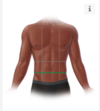Facts to know xx Flashcards
(43 cards)
which vertebrae has most prominent spinous process? [1]
which has next most prominent? [1]
which vertebrae has most prominent spinous process? [1]
C7
which has next most prominent? [1]
T1
what is surface anatomy for oblique fissure?
Anteriorly: T3 to 6th IC cartilage
(no.4 on picture)

what is surface anatomy for horizontal fissure?
horizontal line from sternum at 4th costal cartilage to oblique fissue
(no. 5 in the picture)

out of upper lobe & lower lobes of lungs - which are anterior and more posterior?
out of upper lobe & lower lobes of lungs - which are antieror and more posterior?
Upper: Anterior
Lower: Posterior
where do you find transpyloric plane? what vert level?
L1
what structures does the transpyloric plane cross? [5]
fundus of gallbladder
pylorus
neck of pancreas
origins of SMA & hepatic portal vein
duodenum
kidneys
which lines makes up the 9 squares of abdo?
horizontal
transpyloric (L1)
transtubuercular plane (L5)
vertical:
lines up from mid inguinal point / mid clavicular points

how do u find the transtubercular plane? what level?
L5 level
top of pelvis
Umbilicus correspond to which part of the vertebral column?
L3/ L4
where is mcburneys incision point?
where is the arcuate line?

which organs can you find in the left hypochondriac region?
stomach
top of the left lobe of the liver
left kidney
spleen
tail of the pancreas
parts of the small intestine
transverse colon
descending colon
The right hypochondriac region contains the:?
liver
gallbladder
small intestine
ascending colon
transverse colon
right kidney
the epigastric region contains the?
esophagus
stomach
liver
spleen
pancreas
right and left kidneys
right and left ureters
right and left suprarenal glands
small intestine
transverse colon
The left lumbar region contains?
a portion of the small intestine
a part of the descending colon
the tip of the left kidney
The right lumbar region contains the:
tip of the liver
gallbladder
small intestine
ascending colon
right kidney
The umbilical region contains the:
stomach
pancreas
small intestine
transverse colon
medial extremities of right and left kidneys
right and left ureters
cisterna chyli
The left inguinal region contains:
part of the small intestine
the descending colon
the sigmoid colon
the left ovary and the left fallopian tube in females.
The right inguinal region contains the:
small intestine
appendix
cecum
ascending colon
right ovary and right fallopian tube in females
The hypogastric region contains:
small intestine
sigmoid colon
rectum
urinary bladder
right and left ureters
uterus, the right and left ovaries and the fallopian tubes can be found in females
ductus deferens, seminal vesicles and prostate in males
Which region of the abdomen is found directly inferiorly to the thorax on the left and right sides?
Pectoral region
Hypochondriac region
Lateral region of abdomen
Deltoid Region
Epigastric region
Which region of the abdomen is found directly inferiorly to the thorax on the left and right sides?
Pectoral region
Hypochondriac region
Lateral region of abdomen
Deltoid Region
Epigastric region
Which region of the abdomen should the doctor first palpate to evaluate the size of the spleen?
left hypochondriac region
Which organs are found in the epigastric region?
Descending colon
Eosophagus
Stomach
Urinary bladder
Asceding colon
Which organs are found in the epigastric region?
Descending colon
Eosophagus
Stomach
Urinary bladder
Asceding colon
Which region lies medially to the left and right lumbar regions (Regiones lumbales)?





